Top 10 Dressmaking Lace Fabric Options for Your Next Project
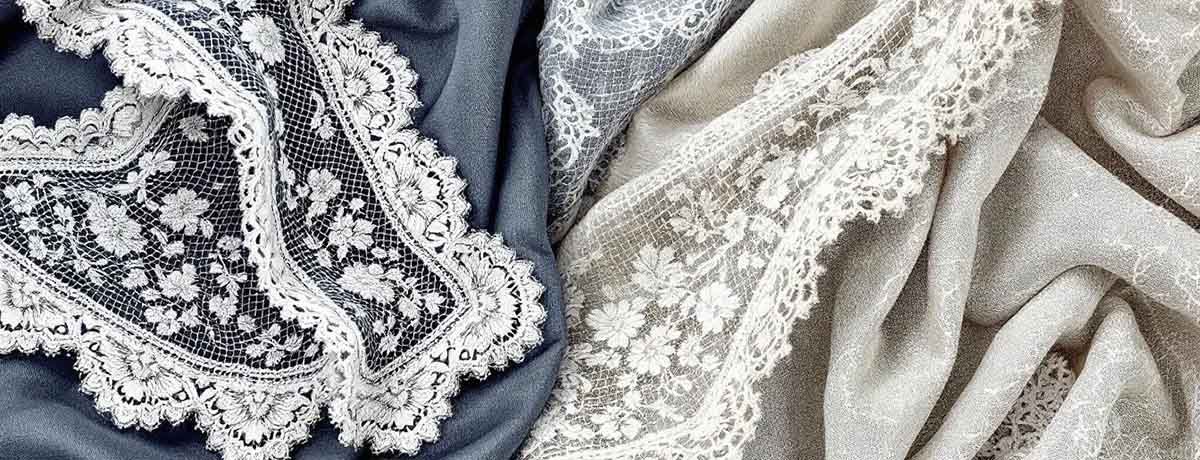
If you’re into dressmaking, choosing the right lace can make all the difference. Dressmaking lace comes in various types, each with its own unique charm and application. In this guide, we’ll explore the top 10 lace fabric options, their uses, and tips for integrating them into your projects effectively.
Key Takeaways
-
Lace fabric has evolved from a luxury material in the Renaissance to a versatile and accessible option for dressmaking, largely due to technological advancements in production.
-
Different types of lace, such as Chantilly, embroidered, and mesh lace, offer unique textures and aesthetics, significantly impacting the design and appeal of garments.
-
Proper care, including gentle washing and appropriate storage, is essential to maintain the integrity of lace garments and ensure their longevity.
Exploring Lace Fabric
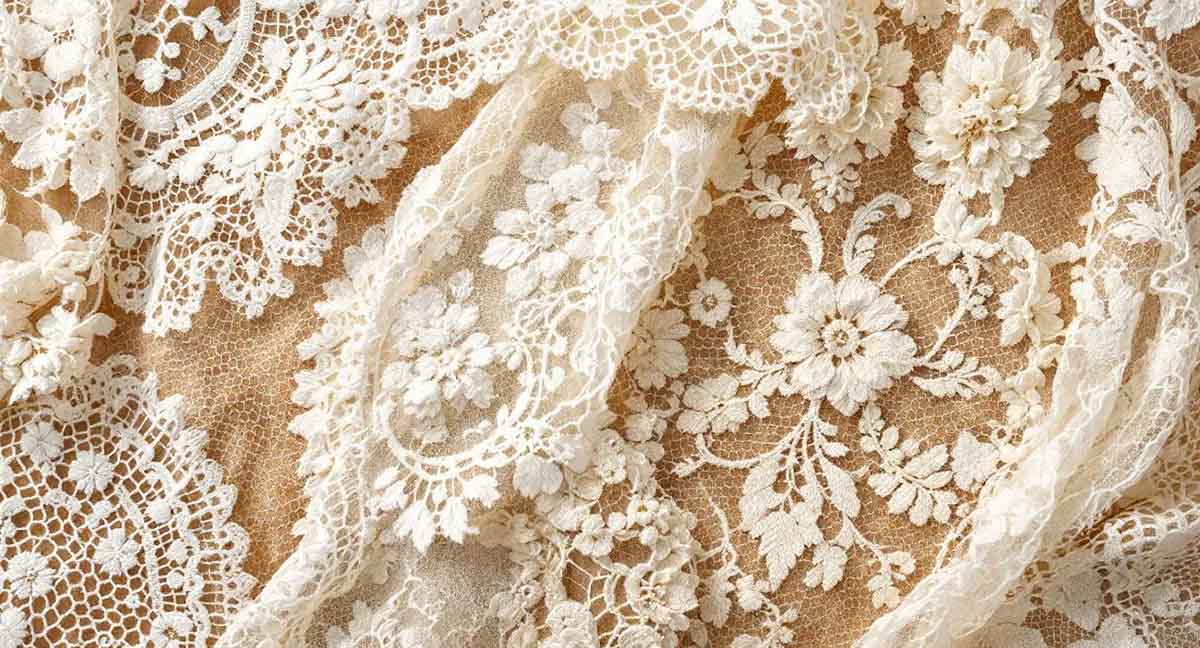
Lace fabric, known for its ornamental openwork, boasts a rich history dating back to the Renaissance:
-
Initially made from linen threads, lace symbolized luxury and status by the 17th century.
-
Post-1800, cotton became a popular choice due to its affordability, making lace accessible to a wider audience.
-
The 19th century saw significant technological advancements, leading to machine-made lace production.
-
This innovation drastically reduced costs, transforming lace from an exclusive luxury to a commonly used fabric.
The primary techniques for creating lace include needle lace and bobbin lace, each demanding different levels of skill and artistry. Needle lace is made by stitching the pattern onto a backing material, which is later removed, leaving the intricate design. Bobbin lace involves twisting and braiding threads around bobbins to create the lace pattern.
These techniques highlight the meticulous effort and artistry that go into making woven lace, contributing to its enduring appeal in fashion.
Types of Lace Fabrics for Dressmaking
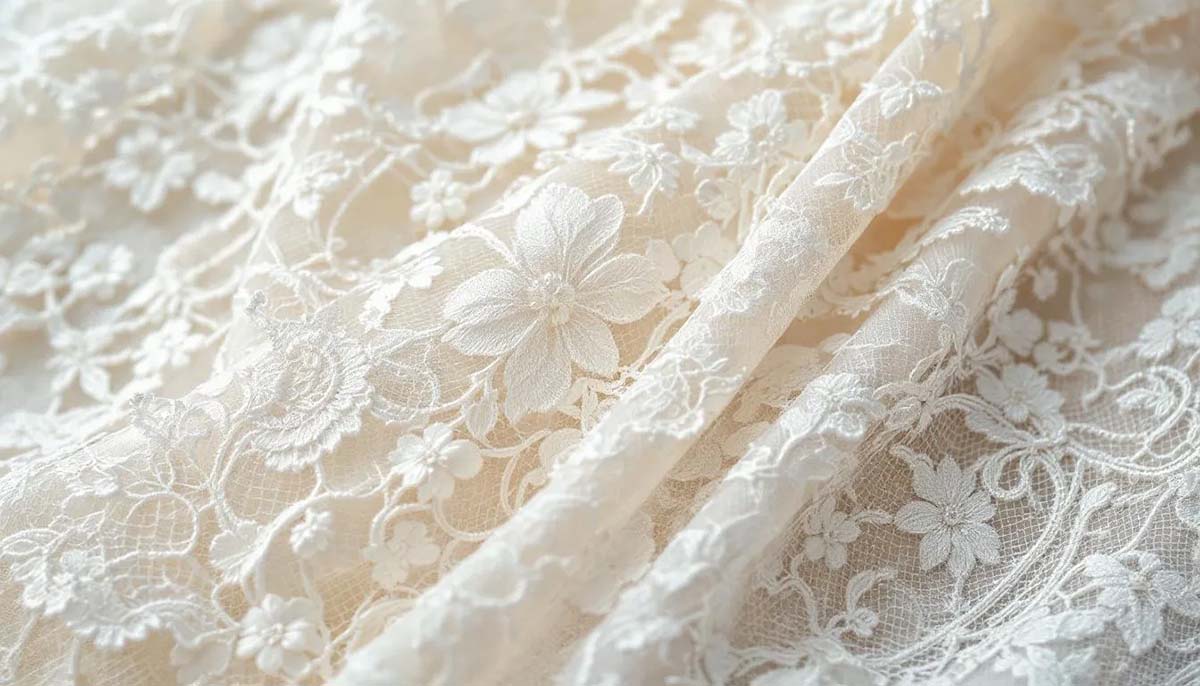
Lace fabrics come in various types, each offering unique textures, weights, and patterns, making them versatile for dressmaking. Knowing the type of lace you’re working with is essential, as it influences how the fabric will be cut and sewn. Premium laces used in wedding dresses include Chantilly, Venise, and Alencon, each providing distinct aesthetic qualities.
Here are some of the most popular options for your next project.
Chantilly Lace
Chantilly lace is renowned for its delicate floral flowers and scroll patterns, typically set against a sheer background. Often associated with elegance, it is commonly used to add sophistication to dresses, blouses, and even curtains. Its intricate designs and fine detailing make it a classic choice for bridal wear and evening gowns, where elegance is paramount.
The delicate trim of Chantilly lace makes it ideal for lingerie and other intimate apparel. Its airy nature adds a romantic and timeless quality to garments, enhancing their overall appeal. Whether creating a wedding dress or haute couture, Chantilly lace can elevate your design with its classic charm and delicate fabric.
Embroidered Lace
Embroidered lace stands out for its decorative stitching patterns, adding rich texture and visual interest to any garment. This lace features intricate designs stitched onto the fabric, offering a unique decorative element that enhances the overall look. Its versatility allows for customization, providing a personalized touch to dresses, blouses, and other garments.
Embroidered lace trims often include beadwork, elevating the visual appeal of any project. Whether creating an elegant dress or a statement blouse, the intricate designs of embroidered lace add elegance and sophistication. This lace is perfect for those looking to make a bold fashion statement with their creations.
Mesh Lace
Mesh lace, with its open weave and flexibility, is a versatile choice for dressmaking. Its lightweight and breathable nature makes it ideal for layering, creating airy and ethereal designs in dresses. This lace fabric is perfect for showcasing intricate designs while maintaining a beautiful drape.
The open structure of mesh lace lends itself well to creating sophisticated styles in dresses and blouses. Whether designing a wedding dress or a casual summer dress, mesh lace offers the flexibility and breathability needed for comfortable and stylish garments. Its versatility makes it a valuable addition to any dressmaker’s fabric collection.
Choosing the Right Lace Trim
Selecting the right lace trim is crucial for achieving the desired look and feel of your dressmaking project. Consider the style and purpose of the garment to ensure the trim complements the overall design. Key factors to consider when choosing lace trim include:
-
Color
-
Type
-
Weight
-
Width
These factors can influence the final outcome.
The width of the lace trim can significantly impact the garment’s aesthetic; narrower trims offer subtle elegance, while broader trims provide a more dramatic effect. By carefully evaluating these aspects, you can select the perfect lace trim to enhance your dress, blouse, or any other creation.
Famous NYC Designer Inspirations
New York City is home to some of the most innovative and boundary-pushing designers, especially in the use of lace fabrics. Padina Bondar, for instance, is known for her avant-grade lace designs that incorporate discarded materials like plastic bags, merging sustainability with high fashion. Many famous NYC designers have embraced intricate designs and timeless elements in their work, often transforming waste into beautiful lace creations.
Exploring their created creations can inspire you to incorporate unique lace elements into your own projects.
Lace Fabric in Wedding Dresses
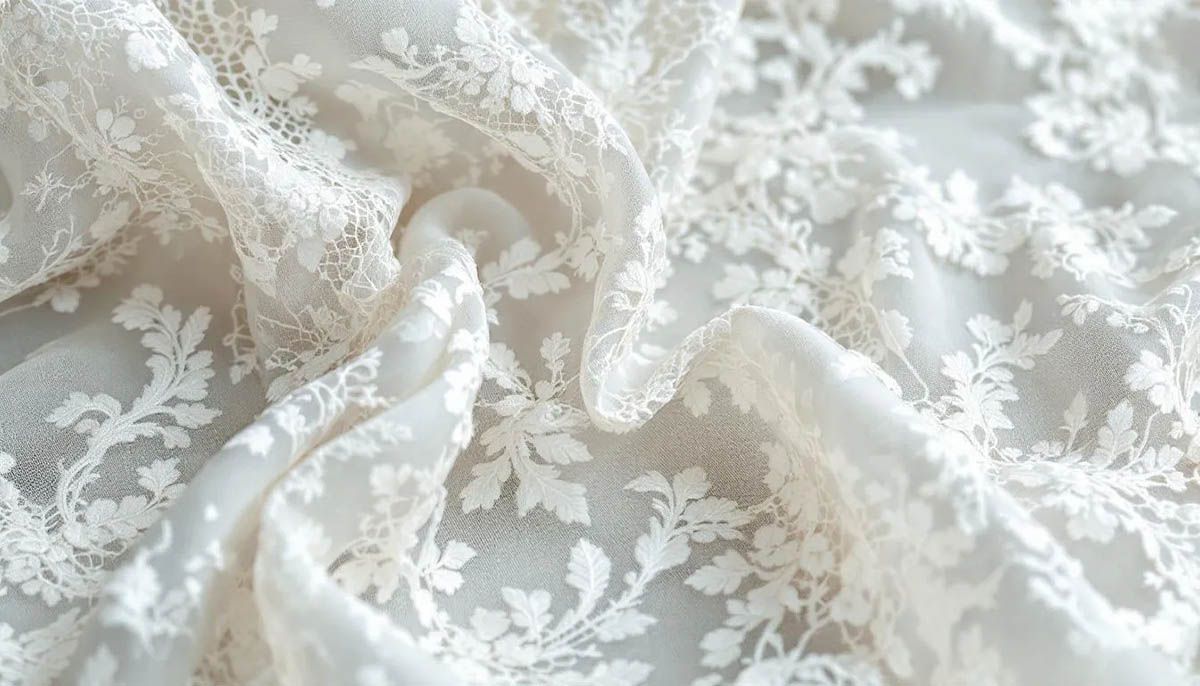
Lace wedding dresses are highly favored for their romantic and elegant appeal. Chantilly lace, with its fine, intricate patterns and sheer quality, is often used in evening gowns and bridal wear due to its elegant and romantic appearance. Lace creates a light and airy effect in wedding gowns, enhancing their ethereal quality.
Layered lace designs can add softness and fluidity, enhancing the overall elegance of the dress. Lace is a classic choice in bridal design, known for its intricate patterns and elegant appearance. Whether you opt for Chantilly lace or another type, incorporating lace into your wedding dress can create a timeless and stunning look.
Fabric Combinations with Lace
Combining lace with other fabrics can enhance the design and comfort of your garments. Silk, for instance, pairs beautifully with lace, enhancing its elegance. Cotton offers a breathable and comfortable alternative, making it suitable for casual wear when combined with lace.
Polyester provides durability and ease of care, making it a practical choice for dressmaking. Experimenting with different fabric combinations allows you to create unique and versatile pieces that showcase the beauty of lace. Whether designing wedding dresses or everyday wear, the right fabric combinations can elevate your creations.
Techniques for Sewing with Lace
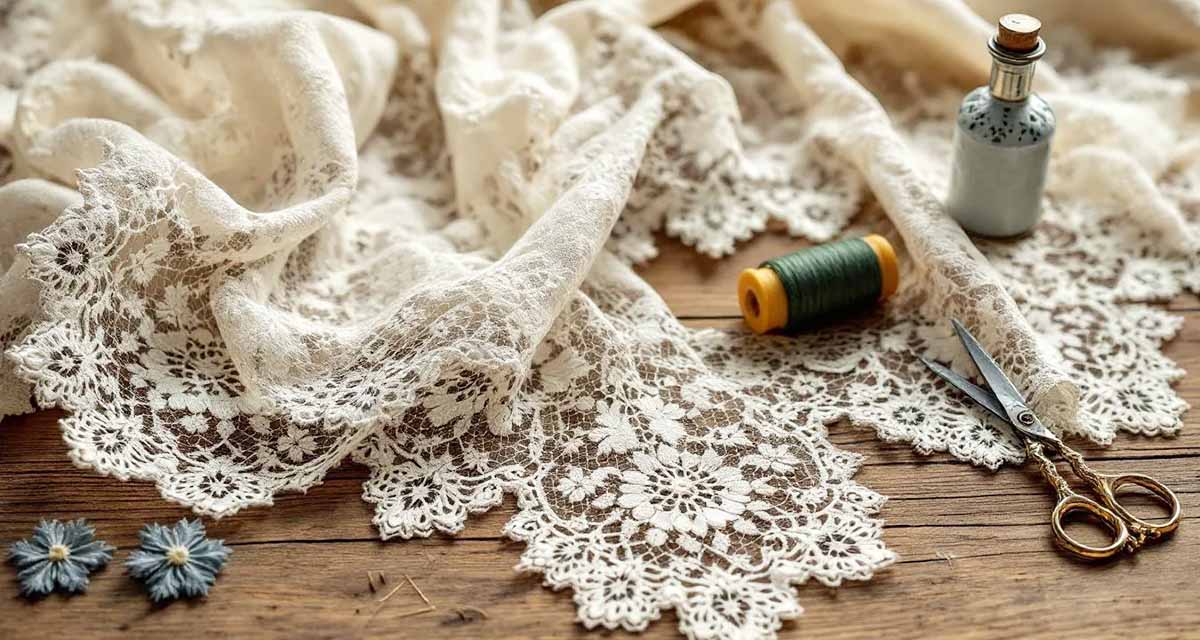
Sewing with lace requires special techniques to maintain its delicate appearance and intricate designs. Establishing a consistent ‘right side’ for lace ensures uniformity in texture and color throughout your project. Invisible seams can help hide bulk and maintain the delicate appearance of lace.
To manage lace’s slippery nature during cutting and sewing, consider the following tips:
-
Use pattern weights instead of pins to manage lace’s slippery nature during cutting.
-
Use thread tracing to effectively mark patterns on lace, as traditional marking tools may not work well.
-
Avoid backstitching to prevent bunching; instead, tie off seam threads manually.
Stitching appliques onto the underlying fabric can add a unique touch to your lace project.
Adding Beads and Accessories
When adding beads and accessories to a lace garment, choose items that enhance rather than compete with the intricate design. A beaded necklace can serve as a vibrant alternative to pearls, especially when adorned with gemstones, but should remain subtle to complement the lace.
Focusing on accessories that highlight the dress’s intricate details creates a harmonious and elegant piece look.
Where to Buy Quality Lace Fabric
Finding quality lace fabric can significantly impact your dressmaking project. Online platforms where you can find lace fabric include:
-
Etsy, which offers a wide range of lace fabrics catering to various styles and budgets.
-
Amazon, providing numerous options complete with customer reviews to guide your choice.
-
Reputable fabric stores’ websites, such as Joann’s and Fabric.com, featuring extensive collections of lace fabric by the yard.
Local fabric shops may also carry quality lace fabrics, allowing you to inspect the materials firsthand. Prices can vary significantly based on material quality and design intricacy. Handmade or designer lace can be more expensive but offers superior quality, making it a worthwhile investment for your projects.
Caring for Your Lace Garments
Proper care is crucial to maintain the beauty and integrity of your lace garments. Follow these guidelines:
-
Always use a gentle detergent designed for delicate fabrics when washing lace.
-
Hand-washing is recommended over machine washing to prevent damage to the delicate threads.
-
Avoid using hot water or applying heat directly to lace, as it can weaken the fibers.
When caring for lace garments, follow these guidelines:
-
Use acid-free tissue paper to prevent creasing when storing.
-
Place lace garments in breathable cotton bags.
-
If ironing is necessary, place a clean cloth over the lace and use the lowest setting on the iron to avoid damaging the fabric.
-
For stains, dab gently with a soft cloth and avoid rubbing the fabric to prevent further damage.
Summary
Lace fabric offers endless possibilities for creating stunning and elegant garments. By understanding the different types of lace, selecting the right lace trim, and mastering sewing techniques, you can bring your dressmaking projects to life. Whether inspired by famous NYC designers or exploring fabric combinations, lace adds a timeless charm to any creation. Remember to care for your lace garments properly to ensure they remain beautiful for years to come. Embrace the versatility and beauty of lace in your next project, and let your creativity shine.
Frequently Asked Questions
What are the main types of lace fabrics used in dressmaking?
The main types of lace fabrics used in dressmaking are Chantilly lace, embroidered lace, and mesh lace, each providing distinct features suited for various garments, ranging from bridal wear to casual styles.
How do I choose the right lace trim for my project?
To choose the right lace trim for your project, focus on the style, color, type, weight, and width that best match your overall design. This will ensure the trim complements and enhances the garment's aesthetic.
Where can I buy quality lace fabric?
You can buy quality lace fabric from online platforms such as Etsy and Amazon, as well as from reputable fabric store websites like Joann's and Fabric.com, or by visiting local fabric shops. Ensure to compare options for the best quality and design that suits your needs.
What techniques should I use for sewing with lace?
When sewing with lace, it is essential to establish a consistent 'right side' and use techniques like invisible seams and pattern weights to manage the fabric effectively. Additionally, avoid backstitching and consider using thread tracing for precise pattern markings.
How should I care for my lace garments?
To care for your lace garments, hand-wash them with a gentle detergent, avoid hot water and direct heat, and store them with acid-free tissue paper in breathable cotton bags. Always dab stains gently rather than rubbing to maintain the fabric's integrity.
Contact MH
MH offer dressmaking lace, feel free to reach out to us for more details or inquiries. We're here to help!


